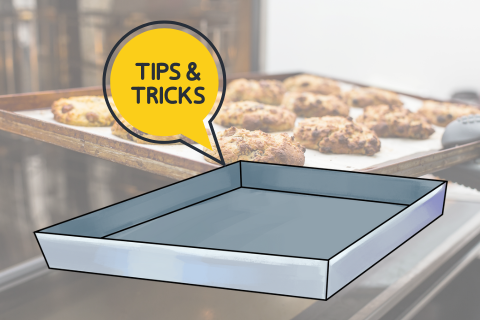Baking trays are the silent heroes of the kitchen, often overlooked but essential for everything from sumptuous sheet cakes to perfectly roasted vegetables. Let's dive into the world of baking trays, exploring their uses, varieties, maintenance, and storage to ensure your baking adventures are always a success.
What are Baking Trays Used For?
Baking trays, or baking sheets as they are sometimes called, offer a flat surface ideal for cooking a myriad of dishes in the oven. Whether it's cookies that need space to spread out or a chicken that needs roasting, baking trays come to the rescue. They're not just limited to baking; they're also perfect for roasting, broiling, and even freezing items in a pinch.
Types Of Baking Trays
The variety of baking trays available is as diverse as the recipes you can create with them. From the classic aluminum tray for even heat distribution to non-stick versions that make cleanup a breeze, there's a tray for every need. Silicone baking mats can complement these trays, providing a reusable non-stick surface.
Aluminum Trays:
Aluminum tray are great for even heating and browning.
Non-Stick Trays:
Non- stick Tray is ideal for easy release of food and quick cleanup.
Stainless Steel Trays:
Stianless Steel Trays are Durable and resistant to warping, but may not distribute heat as evenly.
Silicone Baking Trays
Silicon Baking Mats Can be used on top of trays to create a non-stick surface.
Why Do Baking Trays Bend in the Oven?
Ever heard that alarming pop from the oven? That's your baking tray warping due to the high heat. This happens because of the temperature difference between the hot air in the oven and the cool metal of the tray. While it might sound concerning, it's usually harmless and the tray often returns to its original shape once cooled. Opting for thicker, commercial-grade trays can minimize this effect.
Can You Put Baking Trays in a Dishwasher?
The short answer is, it depends. Many non-stick and aluminum trays are dishwasher safe, but the harsh detergents and hot water can deteriorate the finish over time. Hand washing with mild soap and warm water is generally the best way to extend the life of your trays.
How to Store Baking Trays
Storing baking trays can sometimes feel like a game of Tetris in your cabinets. Vertical dividers in a cabinet or an over-the-door rack can be game-changers, allowing you to slide trays in and out with ease. If space allows, hanging them on a pegboard adds a touch of professional kitchen flair while keeping them within easy reach.
How Often Should You Replace Baking Trays?
The lifespan of a baking tray depends on its material and how well it's maintained. Non-stick trays might need replacing every few years due to wear and tear, while a good-quality aluminum or stainless steel tray can last much longer if cared for properly. Look out for signs of heavy wear, such as deep scratches, rust, or warping that doesn't correct upon cooling.
Find Commercial-Grade Baking Trays at Eurotins
For those looking to step up their baking game, commercial-grade trays like those available at Eurotins offer durability and performance that exceed standard kitchenware. Designed to withstand the rigorous demands of professional kitchens, these trays ensure even heating and longevity, making them a worthy investment for serious home bakers.
Conclusion:
In conclusion, understanding and caring for your baking trays can significantly impact your cooking and baking results. By choosing the right type, maintaining them well, and storing them properly, you'll ensure that these kitchen staples are ready whenever inspiration strikes. And for those in pursuit of perfection, upgrading to commercial-grade options like those from Eurotins can elevate your baking to new heights. Happy baking!
FAQs
1. What can I use my baking tray for besides baking cookies?
Baking trays are versatile kitchen tools used for a range of cooking tasks, including roasting meats and vegetables, baking a variety of sweets like cookies and sheet cakes, broiling foods, and even freezing items flat before transferring them to a more permanent storage solution.
2. Why do my baking trays warp in the oven, and should I be concerned?
Warping occurs due to the temperature difference between the hot air in the oven and the cool metal of the tray, causing it to flex or pop. This is a common occurrence and typically harmless; the tray often returns to its original shape once cooled. Choosing thicker, commercial-grade trays can reduce warping.
3. Can all baking trays be washed in the dishwasher?
While many baking trays are marketed as dishwasher safe, frequent washing in a dishwasher can degrade the finish, particularly for non-stick and aluminum trays. Hand washing with mild soap and warm water is recommended to prolong their life.
4. What are some efficient ways to store baking trays in a small kitchen?
Utilizing vertical storage solutions such as cabinet dividers or over-the-door racks can save space and keep trays organized. If space allows, hanging them on a pegboard adds accessibility and efficiency to your kitchen setup.
5. How do I know when it's time to replace my baking tray?
Signs that it's time to replace your baking tray include deep scratches, rust, significant warping that doesn't revert after cooling, or deterioration of the non-stick coating. Regular inspection and maintenance can help prolong their life, but replacement is necessary when they no longer perform as expected.
6. Are commercial-grade baking trays worth the investment for home use?
Yes, for avid bakers and those seeking durability and professional-grade results, investing in commercial-grade baking trays can be worthwhile. They are designed to withstand high temperatures and frequent use, offering even heat distribution and extended longevity.




